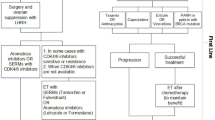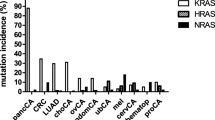Abstract
Purpose
Intra-tumor heterogeneity (ITH) plays a pivotal role in driving breast cancer progression and therapeutic resistance. We used a mutant-allele tumor heterogeneity (MATH) algorithm to measure ITH and explored its correlation with clinical parameters and multi-omics data.
Methods
We assessed 916 female breast cancer patients from The Cancer Genome Atlas. We calculated the MATH values from whole-exome sequencing data and further investigated their correlation with clinical characteristics, somatic mutations, somatic copy number alterations (SCNAs), and gene enrichment.
Results
The patients were divided into low, intermediate, and high MATH groups. High T stage, African American race, and triple-negative or basal-like subtype were associated with a higher MATH level (all P < 0.001). In hormone receptor-positive and human epidermal growth factor receptor-negative patients, the high MATH group showed a tendency toward a worse overall survival (P = 0.052); Furthermore, the TP53 mutation rate increased as MATH was elevated (P < 0.001), whereas CDH1 mutations were correlated with a lower level of MATH (P = 0.002). Several focal and arm-level SCNA events were more common in the high MATH group (P < 0.05), including Chr8q24 with only the MYC gene in the “peak” region. Similarly, high MATH was associated with gene set enrichment related to the MYC pathway and proliferation.
Conclusion
Our integrative analysis reveals the clinical and genetic relevance of ITH in breast cancer. These results also suggest the origin and natural history of clonal evolution and intra-tumor genetic heterogeneity, which warrant further investigation.



Similar content being viewed by others
References
Gerlinger M, Horswell S, Larkin J, Rowan AJ, Salm MP, Varela I, Fisher R, McGranahan N, Matthews N, Santos CR, Martinez P, Phillimore B, Begum S, Rabinowitz A, Spencer-Dene B, Gulati S, Bates PA, Stamp G, Pickering L, Gore M, Nicol DL, Hazell S, Futreal PA, Stewart A, Swanton C (2014) Genomic architecture and evolution of clear cell renal cell carcinomas defined by multiregion sequencing. Nat Genet 46(3):225–233. doi:10.1038/ng.2891
Patel AP, Tirosh I, Trombetta JJ, Shalek AK, Gillespie SM, Wakimoto H, Cahill DP, Nahed BV, Curry WT, Martuza RL, Louis DN, Rozenblatt-Rosen O, Suva ML, Regev A, Bernstein BE (2014) Single-cell RNA-seq highlights intratumoral heterogeneity in primary glioblastoma. Science 344(6190):1396–1401. doi:10.1126/science.1254257
Varley KE, Mutch DG, Edmonston TB, Goodfellow PJ, Mitra RD (2009) Intra-tumor heterogeneity of MLH1 promoter methylation revealed by deep single molecule bisulfite sequencing. Nucl Acids Res 37(14):4603–4612. doi:10.1093/nar/gkp457
Martelotto LG, Ng CK, Piscuoglio S, Weigelt B, Reis-Filho JS (2014) Breast cancer intra-tumor heterogeneity. Breast Cancer Res 16(3):210. doi:10.1186/bcr3658
Hanahan D, Weinberg RA (2011) Hallmarks of cancer: the next generation. Cell 144(5):646–674. doi:10.1016/j.cell.2011.02.013
Burrell RA, McGranahan N, Bartek J, Swanton C (2013) The causes and consequences of genetic heterogeneity in cancer evolution. Nature 501(7467):338–345. doi:10.1038/nature12625
Marusyk A, Almendro V, Polyak K (2012) Intra-tumour heterogeneity: a looking glass for cancer? Nat Rev Cancer 12(5):323–334. doi:10.1038/nrc3261
Szerlip NJ, Pedraza A, Chakravarty D, Azim M, McGuire J, Fang Y, Ozawa T, Holland EC, Huse JT, Jhanwar S, Leversha MA, Mikkelsen T, Brennan CW (2012) Intratumoral heterogeneity of receptor tyrosine kinases EGFR and PDGFRA amplification in glioblastoma defines subpopulations with distinct growth factor response. Proc Natl Acad Sci USA 109(8):3041–3046. doi:10.1073/pnas.1114033109
Engelman JA, Zejnullahu K, Mitsudomi T, Song Y, Hyland C, Park JO, Lindeman N, Gale CM, Zhao X, Christensen J, Kosaka T, Holmes AJ, Rogers AM, Cappuzzo F, Mok T, Lee C, Johnson BE, Cantley LC, Janne PA (2007) MET amplification leads to gefitinib resistance in lung cancer by activating ERBB3 signaling. Science 316(5827):1039–1043. doi:10.1126/science.1141478
Hofmann WK, Komor M, Wassmann B, Jones LC, Gschaidmeier H, Hoelzer D, Koeffler HP, Ottmann OG (2003) Presence of the BCR-ABL mutation Glu255Lys prior to STI571 (imatinib) treatment in patients with Ph+ acute lymphoblastic leukemia. Blood 102(2):659–661. doi:10.1182/blood-2002-06-1756
Morris LG, Riaz N, Desrichard A, Senbabaoglu Y, Hakimi AA, Makarov V, Reis-Filho JS, Chan TA (2016) Pan-cancer analysis of intratumor heterogeneity as a prognostic determinant of survival. Oncotarget. doi:10.18632/oncotarget.7067
Andor N, Graham TA, Jansen M, Xia LC, Aktipis CA, Petritsch C, Ji HP, Maley CC (2016) Pan-cancer analysis of the extent and consequences of intratumor heterogeneity. Nat Med 22(1):105–113. doi:10.1038/nm.3984
Park SY, Gonen M, Kim HJ, Michor F, Polyak K (2010) Cellular and genetic diversity in the progression of in situ human breast carcinomas to an invasive phenotype. J Clin Investig 120(2):636–644. doi:10.1172/JCI40724
Maley CC, Galipeau PC, Finley JC, Wongsurawat VJ, Li X, Sanchez CA, Paulson TG, Blount PL, Risques RA, Rabinovitch PS, Reid BJ (2006) Genetic clonal diversity predicts progression to esophageal adenocarcinoma. Nat Genet 38(4):468–473. doi:10.1038/ng1768
Merlo LM, Maley CC (2010) The role of genetic diversity in cancer. J Clin Investig 120(2):401–403. doi:10.1172/JCI42088
de Bruin EC, McGranahan N, Mitter R, Salm M, Wedge DC, Yates L, Jamal-Hanjani M, Shafi S, Murugaesu N, Rowan AJ, Gronroos E, Muhammad MA, Horswell S, Gerlinger M, Varela I, Jones D, Marshall J, Voet T, Van Loo P, Rassl DM, Rintoul RC, Janes SM, Lee SM, Forster M, Ahmad T, Lawrence D, Falzon M, Capitanio A, Harkins TT, Lee CC, Tom W, Teefe E, Chen SC, Begum S, Rabinowitz A, Phillimore B, Spencer-Dene B, Stamp G, Szallasi Z, Matthews N, Stewart A, Campbell P, Swanton C (2014) Spatial and temporal diversity in genomic instability processes defines lung cancer evolution. Science 346(6206):251–256. doi:10.1126/science.1253462
Heselmeyer-Haddad K, Berroa Garcia LY, Bradley A, Ortiz-Melendez C, Lee WJ, Christensen R, Prindiville SA, Calzone KA, Soballe PW, Hu Y, Chowdhury SA, Schwartz R, Schaffer AA, Ried T (2012) Single-cell genetic analysis of ductal carcinoma in situ and invasive breast cancer reveals enormous tumor heterogeneity yet conserved genomic imbalances and gain of MYC during progression. Am J Pathol 181(5):1807–1822. doi:10.1016/j.ajpath.2012.07.012
Andor N, Harness JV, Muller S, Mewes HW, Petritsch C (2014) EXPANDS: expanding ploidy and allele frequency on nested subpopulations. Bioinformatics 30(1):50–60. doi:10.1093/bioinformatics/btt622
Mroz EA, Rocco JW (2013) MATH, a novel measure of intratumor genetic heterogeneity, is high in poor-outcome classes of head and neck squamous cell carcinoma. Oral Oncol 49(3):211–215. doi:10.1016/j.oraloncology.2012.09.007
Mroz EA, Tward AD, Pickering CR, Myers JN, Ferris RL, Rocco JW (2013) High intratumor genetic heterogeneity is related to worse outcome in patients with head and neck squamous cell carcinoma. Cancer 119(16):3034–3042. doi:10.1002/cncr.28150
Mroz EA, Tward AD, Hammon RJ, Ren Y, Rocco JW (2015) Intra-tumor genetic heterogeneity and mortality in head and neck cancer: analysis of data from the Cancer Genome Atlas. PLoS Med 12(2):e1001786. doi:10.1371/journal.pmed.1001786
Keenan T, Moy B, Mroz EA, Ross K, Niemierko A, Rocco JW, Isakoff S, Ellisen LW, Bardia A (2015) Comparison of the genomic landscape between primary breast cancer in African American versus white women and the association of racial differences with tumor recurrence. J Clin Oncol 33(31):3621–3627. doi:10.1200/JCO.2015.62.2126
Pereira B, Chin SF, Rueda OM, Vollan HK, Provenzano E, Bardwell HA, Pugh M, Jones L, Russell R, Sammut SJ, Tsui DW, Liu B, Dawson SJ, Abraham J, Northen H, Peden JF, Mukherjee A, Turashvili G, Green AR, McKinney S, Oloumi A, Shah S, Rosenfeld N, Murphy L, Bentley DR, Ellis IO, Purushotham A, Pinder SE, Borresen-Dale AL, Earl HM, Pharoah PD, Ross MT, Aparicio S, Caldas C (2016) The somatic mutation profiles of 2433 breast cancers refines their genomic and transcriptomic landscapes. Nat Commun 7:11479. doi:10.1038/ncomms11479
Chen X, Li J, Gray WH, Lehmann BD, Bauer JA, Shyr Y, Pietenpol JA (2012) TNBCtype: a subtyping tool for triple-negative breast cancer. Cancer Inform 11:147–156. doi:10.4137/CIN.S9983
Lehmann BD, Bauer JA, Chen X, Sanders ME, Chakravarthy AB, Shyr Y, Pietenpol JA (2011) Identification of human triple-negative breast cancer subtypes and preclinical models for selection of targeted therapies. J Clin Investig 121(7):2750–2767. doi:10.1172/JCI45014
Mermel CH, Schumacher SE, Hill B, Meyerson ML, Beroukhim R, Getz G (2011) GISTIC2.0 facilitates sensitive and confident localization of the targets of focal somatic copy-number alteration in human cancers. Genome Biol 12(4):R41. doi:10.1186/gb-2011-12-4-r41
Mootha VK, Lindgren CM, Eriksson KF, Subramanian A, Sihag S, Lehar J, Puigserver P, Carlsson E, Ridderstrale M, Laurila E, Houstis N, Daly MJ, Patterson N, Mesirov JP, Golub TR, Tamayo P, Spiegelman B, Lander ES, Hirschhorn JN, Altshuler D, Groop LC (2003) PGC-1alpha-responsive genes involved in oxidative phosphorylation are coordinately downregulated in human diabetes. Nat Genet 34(3):267–273. doi:10.1038/ng1180
Subramanian A, Tamayo P, Mootha VK, Mukherjee S, Ebert BL, Gillette MA, Paulovich A, Pomeroy SL, Golub TR, Lander ES, Mesirov JP (2005) Gene set enrichment analysis: a knowledge-based approach for interpreting genome-wide expression profiles. Proc Natl Acad Sci USA 102(43):15545–15550. doi:10.1073/pnas.0506580102
Cancer Genome Atlas Network (2012) Comprehensive molecular portraits of human breast tumours. Nature 490(7418):61–70. doi:10.1038/nature11412
Gao J, Aksoy BA, Dogrusoz U, Dresdner G, Gross B, Sumer SO, Sun Y, Jacobsen A, Sinha R, Larsson E, Cerami E, Sander C, Schultz N (2013) Integrative analysis of complex cancer genomics and clinical profiles using the cBioPortal. Sci Signal 6(269):pl1. doi:10.1126/scisignal.2004088
Cleator S, Heller W, Coombes RC (2007) Triple-negative breast cancer: therapeutic options. Lancet Oncol 8(3):235–244. doi:10.1016/S1470-2045(07)70074-8
Yin XY, Grove L, Datta NS, Long MW, Prochownik EV (1999) C-myc overexpression and p53 loss cooperate to promote genomic instability. Oncogene 18(5):1177–1184. doi:10.1038/sj.onc.1202410
Kuzyk A, Mai S (2014) c-MYC-induced genomic instability. Cold Spring Harb Perspect Med 4(4):a014373. doi:10.1101/cshperspect.a014373
Andrechek ER, Cardiff RD, Chang JT, Gatza ML, Acharya CR, Potti A, Nevins JR (2009) Genetic heterogeneity of Myc-induced mammary tumors reflecting diverse phenotypes including metastatic potential. Proc Natl Acad Sci USA 106(38):16387–16392. doi:10.1073/pnas.0901250106
Hollern DP, Yuwanita I, Andrechek ER (2013) A mouse model with T58A mutations in Myc reduces the dependence on KRas mutations and has similarities to claudin-low human breast cancer. Oncogene 32(10):1296–1304. doi:10.1038/onc.2012.142
Leung JY, Andrechek ER, Cardiff RD, Nevins JR (2012) Heterogeneity in MYC-induced mammary tumors contributes to escape from oncogene dependence. Oncogene 31(20):2545–2554. doi:10.1038/onc.2011.433
Acknowledgements
We sincerely thank Edmund A. Mroz from Massachusetts General Hospital for the guidance on the generation of MATH value from TCGA publicly available data. This work was supported by grants from the Research Project of Fudan University Shanghai Cancer Center YJ201401 (Y. Z. Jiang), the National Natural Science Foundation of China 81572583 (Z. M. Shao), 81502278 (Y. Z. Jiang), and 81372848 (Z. M. Shao); the Municipal Project for Developing Emerging and Frontier Technology in Shanghai Hospitals SHDC12010116 (Z. M. Shao); the Cooperation Project of Conquering Major Diseases in Shanghai Municipality Health System 2013ZYJB0302 (Z. M. Shao); the Innovation Team of Ministry of Education IRT1223 (Z. M. Shao); and the Shanghai Key Laboratory of Breast Cancer 12DZ2260100 (Z. M. Shao).The funders had no role in the study design, data collection and analysis, decision to publish, or preparation of the manuscript.
Author contributions
YZJ and ZMS designed the experiments. DM, YZJ, and XYL carried out most experiments and analyzed data. YRL provided technical support. DM and YZJ wrote and revised the manuscript.
Author information
Authors and Affiliations
Corresponding author
Ethics declarations
Conflicts of interest
The authors declare no conflict of interest.
Ethical approval
Since the TCGA database is publicly available, ethics committee approval was not needed. Neither patient informed consent nor permission to use this data was required to perform the current analysis.
Additional information
Ding Ma, Yi-Zhou Jiang and Xi-Yu Liu have contributed equally to this work.
Electronic supplementary material
Below is the link to the electronic supplementary material.
Rights and permissions
About this article
Cite this article
Ma, D., Jiang, YZ., Liu, XY. et al. Clinical and molecular relevance of mutant-allele tumor heterogeneity in breast cancer. Breast Cancer Res Treat 162, 39–48 (2017). https://doi.org/10.1007/s10549-017-4113-z
Received:
Accepted:
Published:
Issue Date:
DOI: https://doi.org/10.1007/s10549-017-4113-z




